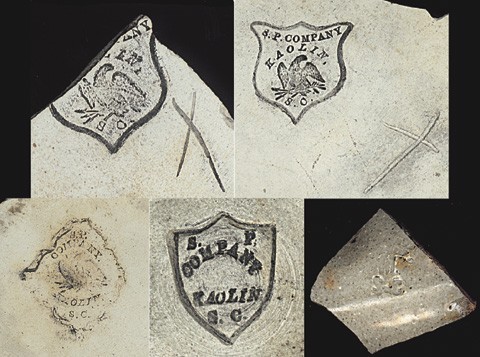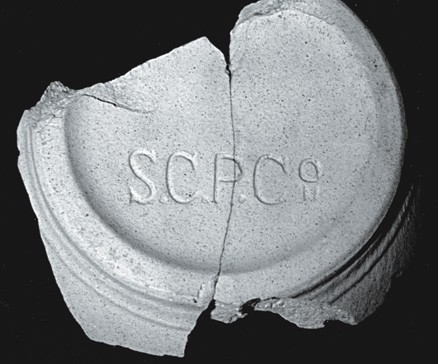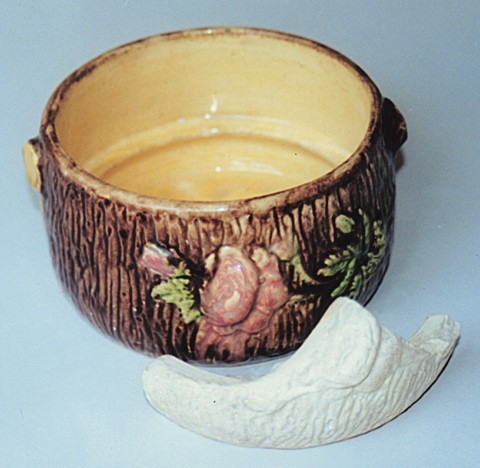
Southern Porcelain Company marks. Top: “S.P. Company/Kaolin/ eagle/S.C.” in a shield. Note the hand inscribed “X” on each sherd. Bottom: (Left) Very light mark “S.P./Company/ eagle/Kaolin/S.C.” in a diamond-shaped cartouche. (Center) “S.P./Company/ Kaolin/S.C.” in a shield. (Right) Four lines of print, but only one is legible: “S.C.” The latter is alkaline-glazed stoneware while the others are biscuit. (Courtesy, Diachronic Research.)

“S.C.P.Co.” mark on biscuit from the kiln. South Carolina Pottery Company. (Courtesy, Diachronic Research.)

Majolica bowl with rose, and biscuit example from the site, marked “S.C.P.Co.” South Carolina Pottery Company. (Courtesy, the Ferrell Collection.)

Majolica bowl with rose, and biscuit example from the site, marked “S.C.P.Co.” South Carolina Pottery Company. (Courtesy, the Ferrell Collection.)

Majolica bowl with rose, and biscuit example from the site, marked “S.C.P.Co.” South Carolina Pottery Company. (Courtesy, the Ferrell Collection.)
The Edgefield-Aiken area of South Carolina is well known for its large-scale production of unique and beautiful alkaline-glazed stoneware. Yet, despite easy access to one of the world’s largest and purest deposits of high-grade kaolin, the area’s industrial production of refined earthenware and porcelain never fully developed. Two nineteenth-century industrial pottery operations did exist, however, and have been the subject of recent research.[1]
The first, the Southern Porcelain Company, was near Bath, South Carolina. The Southern Porcelain Company was first noted in the literature by Edwin AtLee Barber[2] and most recently studied in detail by ceramic historian Garrison Stradling.[3] Potters and businessmen associated with the U.S. Pottery Company in Bennington, Vermont, established the Southern Porcelain Company in 1856. Using northern workmen and managers, they made a variety of wares, including plain white and cream-colored earthenware, high-fired ironstone, porcelaneous stoneware, true porcelain, and Rockingham-type wares. In addition, they produced alkaline-glazed stoneware, porcelain insulators, and firebrick. The factory continued in operation until 1864, when a fire reduced it to rubble.
Examples of the marks used and wares produced at Southern Porcelain are shown in figure 1. Made available for study by a local collector, sherds from the site were analyzed in the summer and fall of 2000.
The other, lesser-known, nineteenth-century industrial pottery was the South Carolina Pottery Company located about ten miles away from the Southern Porcelain Company at Miles Mill near the Edgefield-Aiken border. In 1885 the Aiken Journal and Review noted that “Messrs. Craig of New York, Jervey of Charleston, and Cahill of Edgefield” had established a pottery for the manufacture of “chinaware and porcelain.” The newspaper went on to say that Mr. Craig was “fully informed in all the details of the business, having spent ten years in China.” The pottery appears to have been in operation until 1887—only about two years.
Limited archaeological excavations at the site in 1995 revealed that Craig and his workers made Rockingham-type earthenware and Victorian majolica as well as yellowware, whiteware, and stoneware. Examples of pitchers, bowls, cups, plates, and other forms were found. Most were slip cast and showed some type of molded decoration. A single marked example was found—a bowl that carries the mark “S.C.P. Co.” (fig. 2). As Mr. Stradling pointed out, this mark has been mistaken for the Southern Porcelain Company’s “S.P.Co.” mark more than once.
Several antique vessels produced by the company have been identified over the past few years, some of which match biscuit-fired sherds found at the site. One parallel is a molded bowl with a rusticated wood grain exterior and a single rose branch on the side (fig. 3). It is marked on the base with “S.C.P.Co.”
Another match found is a commemorative plate inscribed “Merry X-Mas and Happy New Year” in a plaque centered on an elaborately decorated background (fig. 4). Yet another plate, an antique owned by a local collector, is glazed and decorated with majolica-type splashes of brown, blue, and green. It is interesting to note that this example also exactly matches one made at about the same time at the Eureka Pottery, in Trenton, New Jersey, which itself was a copy of a Wedgwood pattern.[4]
Collected by a local resident, a biscuit-fired Rebekah at the Well teapot is marked “31/fireproof.” The fireproof mark has been found in many contexts, including the J. Mayer Pottery of Trenton, New Jersey. Presumably Mr. Craig obtained his molds and supplies, and, perhaps, his training there.
The South Carolina Pottery Company stoneware jugs are wheel thrown, glazed with a smooth feldspathic slip glaze in white—a classic Bristol-type glaze—and cinnamon brown. The jugs are wide rimmed, angular shouldered, and cylindrical bodied. A continuous line of impressed circles marks the top of the shoulder and the upper body. The vertical handles are attached at the neck just below the rim and to the shoulder. These jugs are distinctly different in form, decoration, and glaze from the wares of other local potters.
It is surprising, then, that none of Craig’s wares have been identified in archaeological contexts elsewhere in the state. This gap may result because of the difficulty in distinguishing his products—particularly the seldom-marked yellowware, whiteware, and Rockingham-type ware—from those that were made extensively elsewhere. The stonewares made at this site are distinctive, though, and should be easy to identify.
Similarly, recognizable products of the Southern Porcelain Company, which was in business much longer, are few. And none have been identified in domestic archaeological contexts, possibly due to the lack of comprehensive study of both these potteries. With further excavations and analyses, perhaps some headway can be made in attributing unmarked wares, and these two doomed attempts at industrial activity in the ultra-agrarian South will be better understood.
ACKNOWLEDGMENT
The author thanks Steve and Terry Ferrell for allowing him to photograph vessels in their collection and Gary Dexter for serving as a go-between and obtaining marked Southern Porcelain sherds for photography.
Carl Steen
President
Diachronic Research Foundation
Carl Steen, An Archaeological Survey of Pottery Production Sites in the Old Edgefield District of South Carolina (Columbia, S.C.: Diachronic Research Foundation, 1994).
Edwin Atlee Barber, The Pottery and Porcelain of the United States (New York: Feingold and Lewis, 1904).
J. Garrison Stradling, “The Southern Porcelain Company, S.C.: A Reassessment,” Journal of Early Southern Decorative Arts 22, no. 2 (1996): 1–39.
Marilyn Karmason and Joan Stacke, Majolica: A Complete History and Illustrated Survey (New York: Harry M. Abrams, 1989), p. 189.
